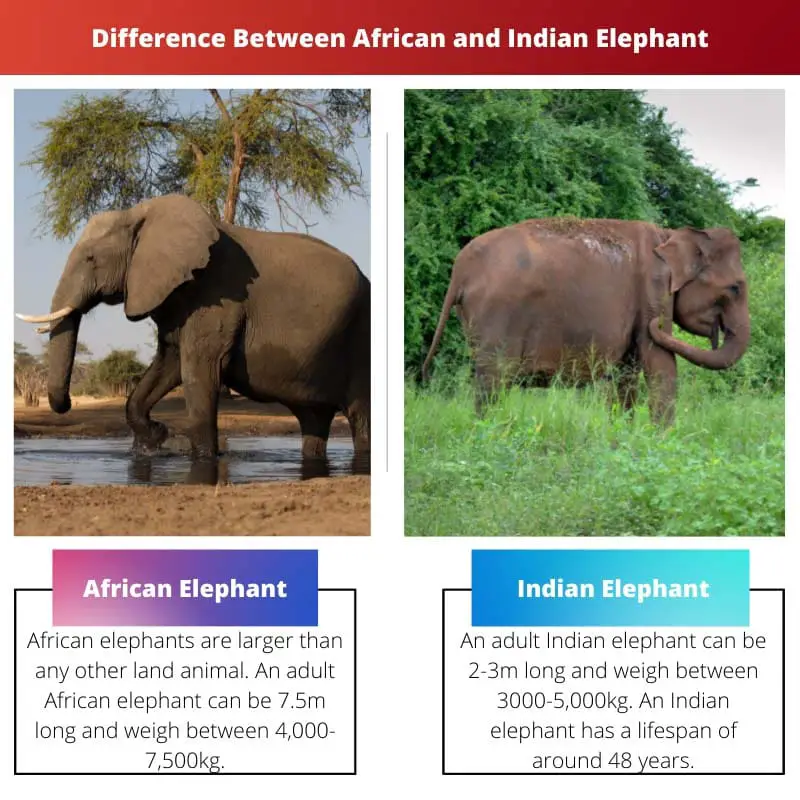No other land animal is as large as an elephant. Even though they are enormous, their cuteness and jovial nature win the hearts of humans. Elephants are native only to Africa and Asia, and the two have physical differences.
Key Takeaways
- African elephants are larger than Indian elephants, with longer tusks and bigger ears.
- African elephants have a concave back, while Indian elephants have a convex back.
- African elephants have two finger-like projections at the tip of their trunks, while Indian elephants have only one.
African Elephant vs Indian Elephant
African elephants are heavier and more robust than Indian elephants. Many physical characteristics are there that distinguish the two. They can be determined by the size of their ears and the shape of their heads.

African elephants are huge and heavy. All African elephants have tusks. They have substantial fan-shaped ears and a round head. Their nose and upper lip make trunks with two finger-like features on the end.
This trunk has multiple uses and is very crucial for elephants.
Indian elephants are smaller in size. They have small ears but long tails. Only some male Indian elephants have tusks. They have two domes on their heads.
They spend their day walking a long way, which is very important for the ecosystem, to ply.
Comparison Table
| Parameters of Comparison | African Elephant | Indian Elephant |
|---|---|---|
| Size | African elephants are more significant than Indian elephants. | Indian elephants are smaller than African elephants. |
| Weight | The average weight of an African elephant is between 4,000-7,500kg. | The average weight of an Indian elephant is between 3000-5,000kg. |
| Tusks | Both male and female African elephants grow tusks. | Only a few male Indian elephants grow tusks. |
| Size of ears | African elephants have large fan-shaped ears. | Indian elephants have small-sized ears. |
| Shape of head | African elephants have fuller, rounder heads. The top of their leaders has a single dome. | An Indian elephant has a twin-domed head with an indent in the middle. |
| Lips | African elephants have short and round lips. | Indian elephants have long and tapered lips. |
| Ribs | African elephants have more ribs. | Compared to African elephants, Indian elephants have fewer ribs. |
| Trunk | African elephants got hard and heavily ringed trunks. | Indian elephants’ trunks are not as heavy as African elephants. |
| Tail | African elephants have short tails. | Indian elephants have longer tails. |
What is African Elephant?
African elephants are more significant than any other land animal. An adult African elephant can be 7.5m long and weigh between 4,000-7,500kg. Elephants have a lifespan of 70 years.
Their trunks are an amalgamation of their nose and upper lips. They use their trunks to smell, breathe and drink. They also use it to handle food and other objects, and it is also their mean of communication.
There are two types of African elephants, African Savanna or bush elephant and African forest elephant. The African forest elephant is more miniature and has different coloured tusks. They also differ in the shape and size of their ears and skulls.
Both male and female African elephants have tusks. However, males have more prominent tusks than females. Bush elephants’ tusks are curving, while on the contrary, forest elephants’ tusks are straight.
African elephants feed themselves with leaves and branches of bushes and trees. They also eat fruits and bark. These elephants can eat around 136kg of food in a single day.

What is Indian Elephant?
An adult Indian elephant can be 2-3m long and weigh between 3000-5,000kg. An Indian elephant has a lifespan of around 48 years.
They have longer tails compared to other elephants. They have large heads but small necks, so their legs carry their body weight. Indian elephant trunks have no bones and have 40,000 muscles in them.
Indian elephants wander around most of the day and need large areas to live. They inhabit from forest to grassland.
These animals spend 19 hours a day eating. They mainly eat grass but also consume fruits like bananas and sugarcane. They also eat stems, roots, and bark.
They defecate 16-18 times a day while wandering, and this way, they fill a large portion of land with their dung which helps to scatter seeds and nutrients on the ground. This is why elephants have been given the designation of ecosystem engineers.
Elephants also eat plants and clear the land for new possibilities. Elephants are intelligent animals with complex social lives similar to humans.

Main Differences Between African and Indian Elephant
- African elephants are heavier than Indian elephants. They are more significant than Indian elephants.
- African elephants have one dome on their head, which means they have round heads. Indian elephants, on the other hand, have a twin-domed authority as they have an indent in the middle of their head.
- Though African and Indian elephants eat similar kinds of food, they mostly eat leaves and branches of bushes and trees, and Indian elephants fill their stomach with grass.
- A fascinating thing about elephants is their tusks. But all elephants do not have tasks. Only some male Indian elephants have tasks. In comparison, both male and female elephants of Africa have tusks. But male Indian elephants’ tusks are curved and thicker than African elephants. Indian elephants’ teeth are more tightly compressed.
- African elephants have enormous ears, whereas Indian elephants have smaller ears.
- African elephants got more wrinkled skin than Indian elephants.




